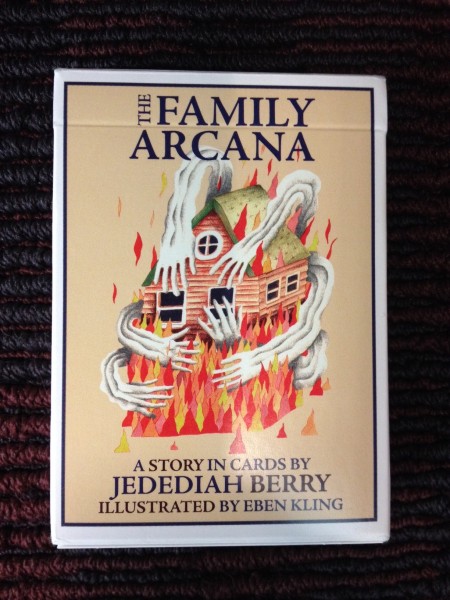
by Tara Laskowski
Here’s a genius idea: take a creepy gothic story about a family living in a possibly haunted house and break it up and put the pieces on playing cards. Jedediah Berry and the folks at Ninepin Press did just that with “The Family Arcana: A Story in Cards” and the results are brilliant and wonderful.
The instructions are simple: shuffle the deck however you want and start reading. You can read this story in any direction, but no matter which direction you read the cards, the different micro-flashes illuminate the odd but charming family that Berry has portrayed here.
Each card reads like it’s own micro-flash—some dark and creepy:
“A man comes around, offering to sharpen our knives. We offer to show him how it’s really done.”
And some with a lighter charming sense of humor:
“In a part of the attic that no one knows but us, we sit on the floor and on the rafters and on old broken chairs, and movements are made and seconded, and votes are cast, and in this way decisions are made. You probably want to know what we’re voting on now, but that isn’t how this goes.”
It’s hard to keep track of all the family members here—endless aunts and uncles, it seems—but after awhile it’s more about the quirky logic and rituals of these people. The true delight is getting lost in this house for a time, then being able to shuffle your deck and do it all over again.
I was so fascinated with both the story itself and its form that I had to catch up with Berry via email to ask him more about the behind-the-scenes. Here’s our chat:
 I’m so curious about the process of writing this story. Did you write the story one particular way and then break it up, or did you write it more piecemeal as images came to you?
I’m so curious about the process of writing this story. Did you write the story one particular way and then break it up, or did you write it more piecemeal as images came to you?
I wrote “The Family Arcana” by hand on index cards, limiting myself to one side of one card for each section. For the few years that I worked on the story, I always kept a little stack of index cards handy, and I’d take them out whenever a new snippet of language occurred to me. Sometimes I’d write a few cards in a sitting, sometimes just one. Once or twice, I wrote a dozen in quick succession.
Do you have a favorite or preferred way to read the text?
I’ve heard of people getting interesting results by playing games of solitaire and reading the stacks, or playing poker and reading their hands. These days, what I most enjoy is getting to shuffle and read it in front of an audience. Not because I’m a natural performer by any means, but because I enjoy the tension of not knowing exactly what’s going to happen. It’s probably the closest I’ll ever get to being a magician.
How did you choose which fragments ended up on which card?
Toward the end of the revision process, I did start assigning the texts to specific suits and ranks. There’s a system to it—the hearts, for example, are all about Mother and Father, and the diamonds all have to do with the setting—but it’s a purposefully imperfect system. I wanted to achieve a certain kind of balance without making the structure too rigid.
I love how the characters have this creepiness about them but also have a really great dark sense of humor. How did they develop for you as people as you wrote this?
I think of them as both playful and wounded. The story they tell comes from a place of suffering, but they delight in the telling. They’re scoundrels and tricksters, but there’s a fierceness in their love for one another and for their home. I felt a real sense of urgency while writing of this story, and I think it has everything to do with that balance of hurt and humor.
What other alternative-text or hybrid projects are you working on now? What’s next?
I just finished work on an interactive science fiction story called “Fabricationist DeWit Remakes the World.” It’s freely available online, and it uses a branching structure to tell a story with more than one possible ending. Also, as an editor at Ninepin Press, I’m looking forward to publishing works in unusual forms by other writers. We have one new project in the works, with more on the way soon.
Tara Laskowski has been the editor of SmokeLong Quarterly since 2010.

 The core workshop of SmokeLong Fitness is all in writing, so you can take part from anywhere at anytime. We are excited about creating a supportive, consistent and structured environment for flash writers to work on their craft in a community. We are thrilled and proud to say that our workshop participants have won, placed, or been listed in every major flash competition. Community works.
The core workshop of SmokeLong Fitness is all in writing, so you can take part from anywhere at anytime. We are excited about creating a supportive, consistent and structured environment for flash writers to work on their craft in a community. We are thrilled and proud to say that our workshop participants have won, placed, or been listed in every major flash competition. Community works.